Adverb DefinitionIntroductionSimilar to how an adjective offers additional detail about the noun in a phrase, an adverb can give us additional information about the verb or the actions in the phrase. Additionally, it can describe an adjective or the other adverb. Adverb DefinitionThe Oxford Learner's Dictionary defines an adverb as "a word that adds further information about location, time, method, cause, or degrees to an adjective, a verb, a phrase, or another adverb." The Cambridge Dictionary defines an adverb as "a word that characterizes or offers extra details of a verb, adverb, adjective, or phrase." 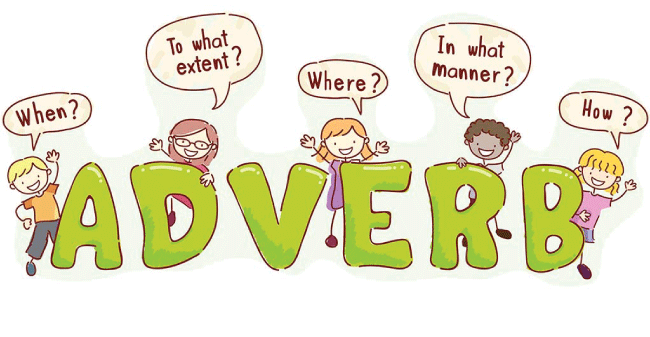
According to the definition, an adverb is "a word used to alter a verb, an adjective, or other adverb and is frequently employed to convey degree, manner, location, or time." The Collins Dictionary defines an adverb as "a term that provides information about action, event, or condition stated in a phrase", such as "slowly," "now," "extremely," "politically," or "fortunately." Similar terminology can be found in the Merriam-Webster dictionary. Examples of AdverbsAdjectives, prepositions, and other adverbs can all be modified by an adverb. An adverb can be used to alter or clarify a phrase. Let's look over the following examples.
Here, the word "brave" is used as an adjective to describe "Rohan," while the word "very" is used as a modifier. The fact that Rohan is considerably braver than other people is made more clear by the adverb "very."
A similar way to alter a preposition is by using an adverb. Here, the adverb "aggressively" is used to alter the verb "played," and the adverb "very" is used to alter the adverb "aggressively" itself. The following example will help you to understand.
In this sentence, the adverb "exactly" changes the preposition by emphasizing it, and the preposition "above" clarifies the aircraft's relative location. Let's look at one more adverb use.
Here, using the word "fortunately," It becomes increasingly obvious that She was fortunate to acquire that position. How do adverbs function inside sentences?By indicating how, where, when, and to which extent something occurs, adverbs give context to sentences. Adjectives, verbs, and even additional adverbs can all be modified by adverbs. Examples:
Adverbs can also convey opinions or make judgments about whole phrases. Comma separation is commonly used to separate these sentence adverbs. Examples:
Adverbs vs. AdjectivesAdjectives can only alter nouns and pronouns (such as "the red door"), but adverbs can alter verbs, adjectives, and sentences. 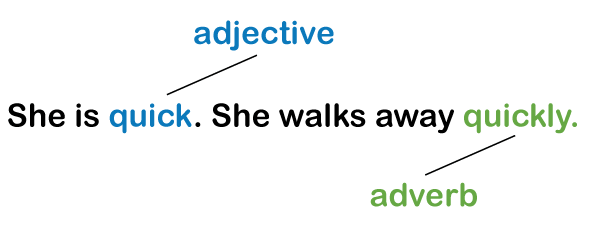
An adjective is frequently transformed into an adverb by adding the suffix "-ly." Depending on the ending, various adverbs can be created from adjectives. 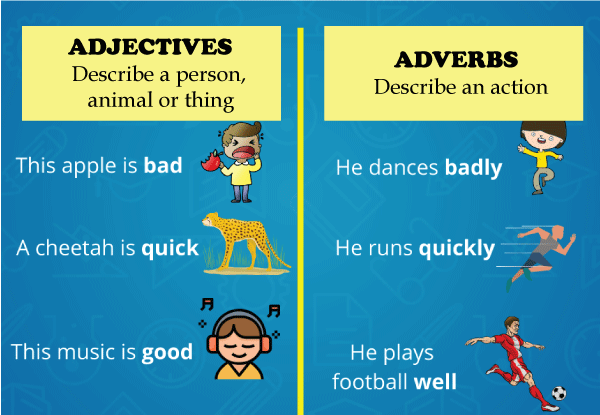
In certain cases, adverbs and their corresponding adjectives have the same form. These are flat adverbs, such as "straight," "quick," and "early." Other adverbs, like "never," lack an adjective that matches them. Linking verbs and adverbsAdverbs can occasionally be mistaken for adjectives when employed with linking verbs-that is, a verb that joins the subject of a phrase with a subject complement that describes it. While connecting verbs (such as "see," "feel," "sound," and "be") can relate to actions, they can also refer to conditions of being. Therefore an adjective is preferred over an adverb in these cases. 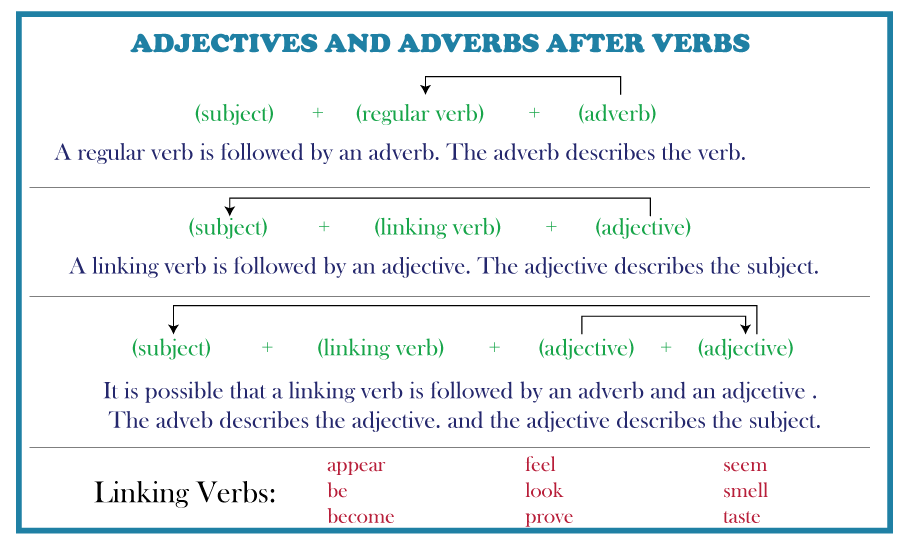
Examples:
Adverbs TypesAdverbs are divided into many types based on their use in sentences. Here are several categories of adverbs. 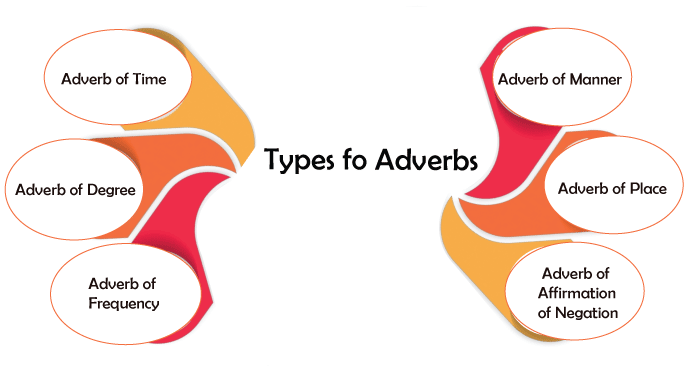
1. Adverbs of Quality and Manner: The adverbs of quality and manner describe how a task or action is carried out. It is easier to understand how the activity is carried out when an adverb of quality and manner is included. 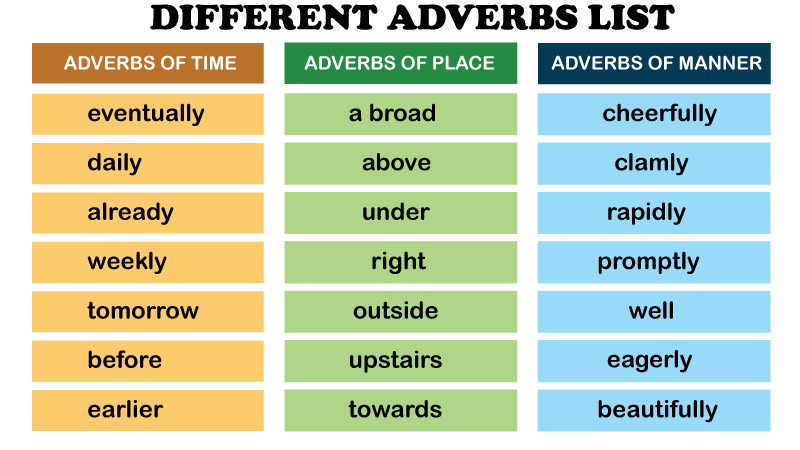
Examples: Rapidly, seriously, immediately, intensely, swiftly; distinctly; progressively; ultimately, etc.
2. Adverbs of Time: These adverbs describe the moment an action occurs. They tell us whether the activity has already occurred or is about to occur. 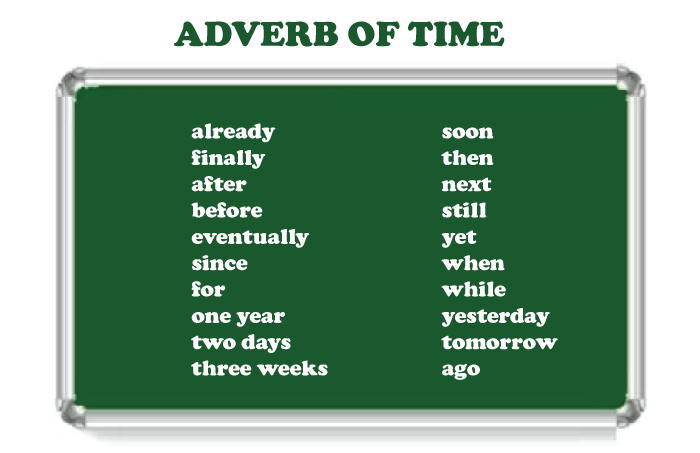
Examples: presently, shortly, today, tomorrow, a day after tomorrow, the next month, most recently, forever, etc.
3. Adverbs of Place: These adverbs can be used to describe the location of an activity that is stated in a sentence. The word "where" can be used to locate adverbs of place. 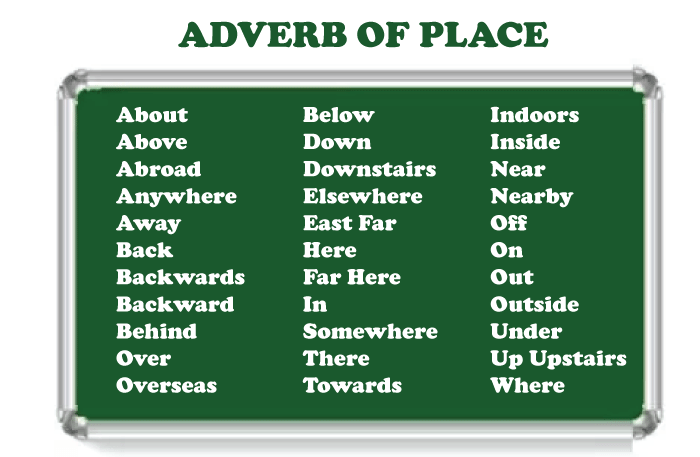
Examples: anywhere, everywhere, nowhere, right here, outside, inside, whenever, elsewhere, left, and any of the four directions.
4. Adverbs of frequency: These adverbs describe how frequently an action or occurrence occurs. Asking "how frequently" will help you identify the frequency of adverbs. 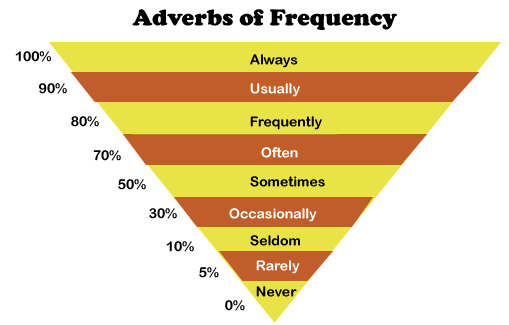
Examples: seldom, rarely, never, regularly, monthly, weekly, yearly, annually, typically, sometimes, frequently, etc.
5. Adverbs of Degree: They are used to describe the level of intensity of an action or attribute. It is employed to define adverbs and adjectives. For instance, a way adverbs can tell how quickly or slowly a car is driving, how cold or hot it is outside, how interesting or dull a movie is, and so on. 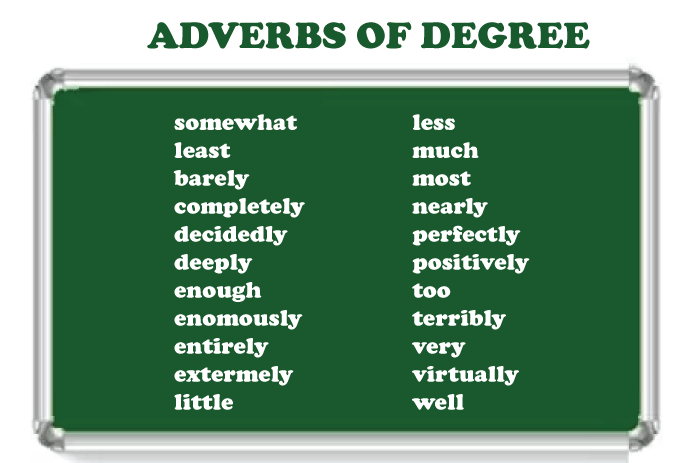
Examples: astonishingly, completely, considerably, hardly, deeply, barely, very, too, exceedingly, more, more, much, little, less, etc.
6. Adverb of Affirmation or Negation:In some lines, there is an attitude of total acceptance or rejection. For this, an adverb of negation or affirmation is employed. 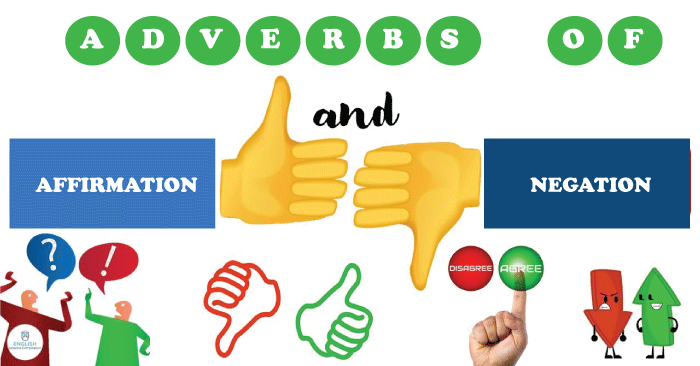
Example:
Other types of adverbsIt's also important to take into account the following additional adverb categories: 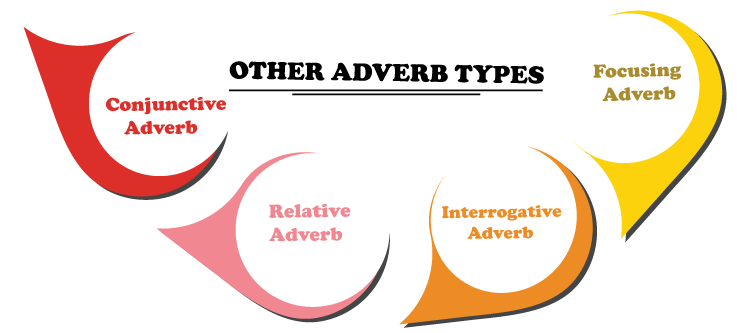
1. Conjunctive adverbs: Adverbs in the conjunctive form function differently than other adverbs. Conjunctive adverbs connect two phrases or clauses by acting as a conjunction. 
Examples: Nevertheless, although, even so, however, instead, similarly, specifically, afterwards, rather, on the other hand, unexpectedly, also, etc.
2. Focusing Adverbs: Adverbs employed to emphasize a specific sentence area are called focusing adverbs. They are often placed alongside the word they are highlighting. "Only," "just," "particularly," "even," "either," and "neither" are a few examples of typical focusing adverbs. 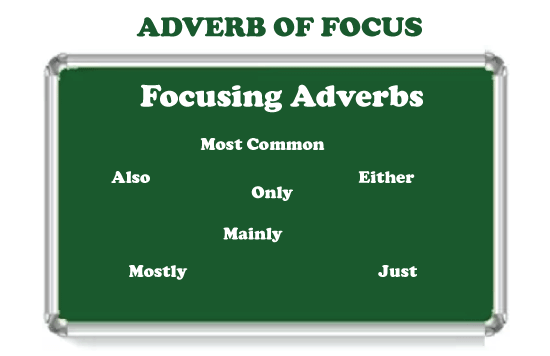
Examples:
3. Interrogative Adverbs: Adverbs that act as questions are known as interrogative adverbs, and they are employed whenever a question is asked and the word "why" is added to the end of the sentence. They are used at the start of sentences, which gives them a certain quality. 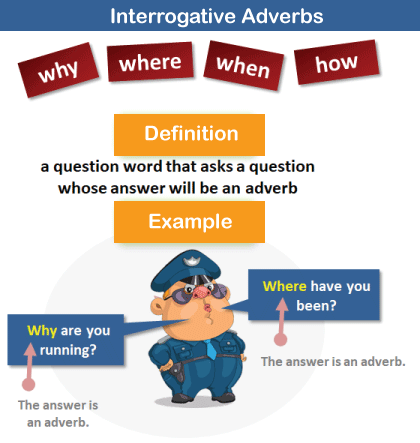
Why do you speak to him, for instance? "Why" is utilized as an adverb in this sentence. In other words, "why" is a questioning adverb. Examples:
4. Relative adverbs: We employ relative adverbs whenever we relate, link, or connect any two statements. There are three of these adverbs: when, where, and why. 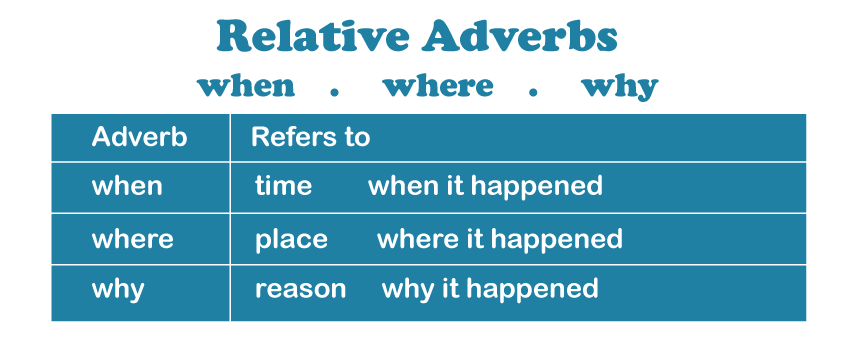
'I saw him when nobody was around,' for instance. The adverb "when" in this instance joins the lines "I saw him" and "Nobody was around." Thus, the relative adverb, in this case, is "when." Examples:
Adverb RulesLet's look at some quick principles that should be observed while employing adverbs in sentences. Rule 1: The adverbs "too much" and "much too" are associated with nouns and adjectives, respectively.
Rule 2: An adjective should be used in the positive form before the word "enough." Rule 3: Do not combine the adjective "Handsome" with the word "quiet" (which indicates perfectly/completely). Rule 4: "Late/Lately." Lately signifies recently, while the adverb "late" denotes time. Rule 5: The rule of inversion should be utilized (i.e., an auxiliary verb is used before the subject) when a phrase starts with "rarely / never / hardly / seldom / scarcely / barely / neither / never." Rule 6: The adverbial phrase "No less than" should be used when referring to uncountable nouns, whereas "No fewer than" is used for countable nouns. Rule 7: An adverb (As) is inappropriate after a call and consideration. Rule 8: Derivative adjectives like interested, happy, satisfied, pleased, and thrilled are used with "much" but not "very." Rule 9: "Very" and "much" are associated with positive adjectives and comparative adjective forms, respectively. Rule 10: "Very much" is appropriate for comparative forms. Adverb ClauseAdverb clauses change verbs, adjectives, and other adverbs in the same manner that common adverbs are used, even though they are complete sentences. Although adverbs are single words, they can also describe a whole phrase, referred to as an adverb clause. Adverb clauses frequently start with conjunctions like before, if, because, and whenever, just like most dependent clauses do. We must leave before the mall shuts, for instance, where the adverb phrase before the mall shuts changes the verb leave. Adverb Clause ExamplesThere are numerous methods to use adverb clauses:
Like adverbs, an adverb clause can occasionally be moved, and the sentence will still make sense. Examples:
Next TopicAir Pollution Definition
|
 For Videos Join Our Youtube Channel: Join Now
For Videos Join Our Youtube Channel: Join Now
Feedback
- Send your Feedback to [email protected]
Help Others, Please Share









